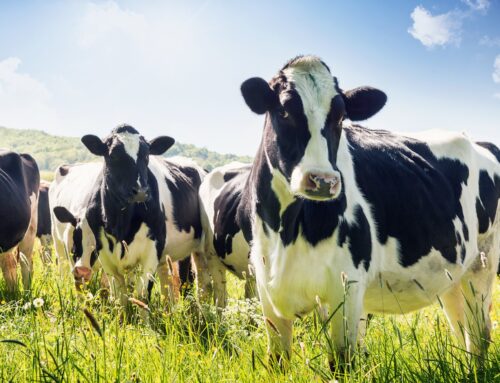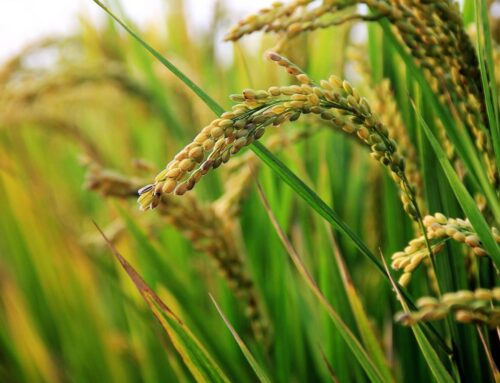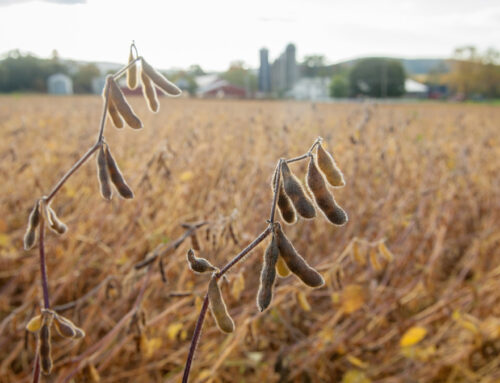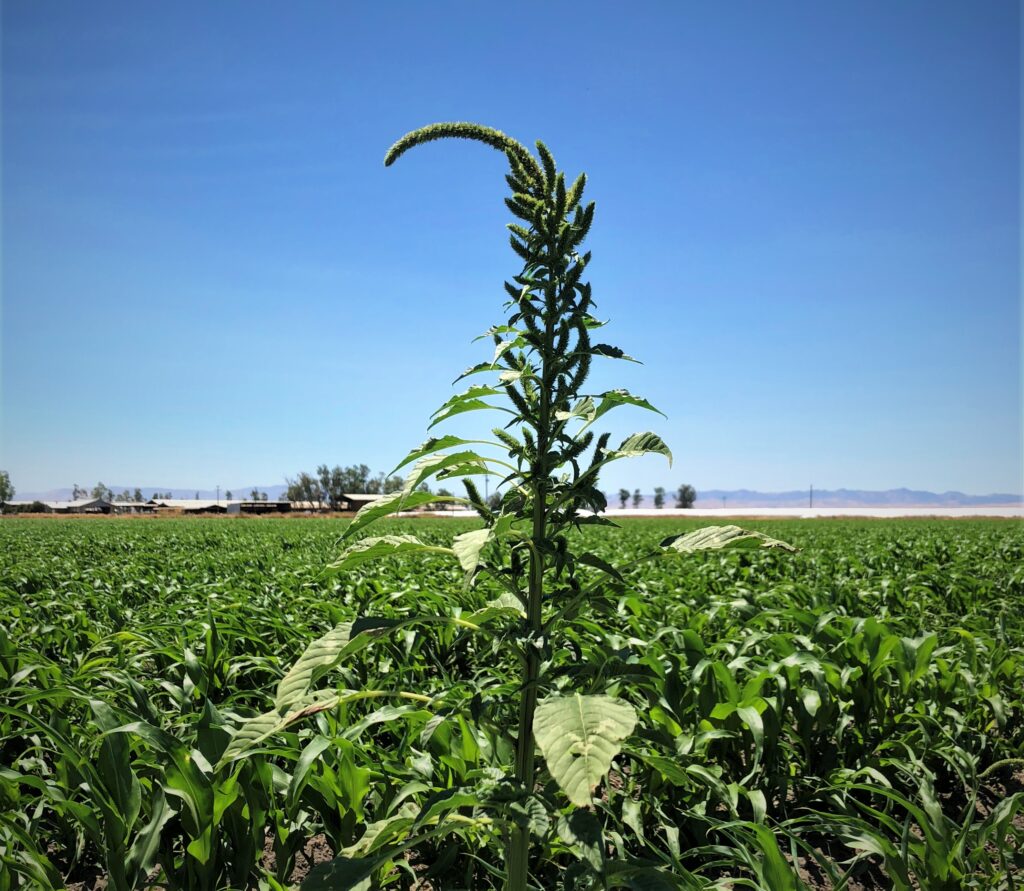
Could Palmer Amaranth, the king of resistant weeds and crippler of herbicides, be dethroned by its own sex drive? An innovative, herbicide-free technology is under testing and aims to attack Palmer pigweed with its own pollen.
WeedOut harnesses a remarkably simple, yet unprecedented approach to weed control. Pollen, treated with radiation to ensure sterility, is applied over Palmer-infested fields to serve as an enticing Trojan horse. Female Palmer plants latch onto the irradiated pollen and eventually abort seed, killing off much of the next generation of resistance. WeedOut’s potential to drain the seedbank is catching notice, and when used in complement with the present arsenal of management tools, could offer a heavy pollen punch, particularly in the present age of diminishing herbicide returns.
A Cruel Numbers Game
 Palmer amaranth devours farmland, and whether consuming yield, chemical expenses, labor, or time, Palmer is insatiable. Present in roughly 40 states (rapid expansion from a 15-state presence in 2005), the weed is a farming nightmare, capable of navigating the survival seam and eventually outlasting every chemical formulation in the tank. A notorious yield-robber of corn, cotton, soybeans, and many more crops, Palmer can climb 7’-plus in height, and cause significant farm machinery damage. A weed beast with few peers, Palmer can jump 1-2” daily and pass out of a controllable stage in 24 hours. Afflicted growers know the plain truth: The logistics of controlling Palmer post-emergence is extremely difficult.
Palmer amaranth devours farmland, and whether consuming yield, chemical expenses, labor, or time, Palmer is insatiable. Present in roughly 40 states (rapid expansion from a 15-state presence in 2005), the weed is a farming nightmare, capable of navigating the survival seam and eventually outlasting every chemical formulation in the tank. A notorious yield-robber of corn, cotton, soybeans, and many more crops, Palmer can climb 7’-plus in height, and cause significant farm machinery damage. A weed beast with few peers, Palmer can jump 1-2” daily and pass out of a controllable stage in 24 hours. Afflicted growers know the plain truth: The logistics of controlling Palmer post-emergence is extremely difficult.
Female Palmer amaranth plants house a seed population nuclear bomb. Pigweed, hogweed, devilweed, or a dozen more colorful monikers—Palmer plays a cruel numbers game fueled by phenomenally prodigious seed production. In a field situation, competing for resources alongside crops, female Palmer can easily produce 50,000 to 200,000 seeds, and if the competition dial is slightly turned down, sometimes can churn out 1 million seeds. Once in the seedbank, Palmer seed can remain viable for at least four to five years. (Stowaways on ag equipment, free from moisture or insect pressure, may last longer.)
Traditionally, the most effective way to fight Palmer is to strike well before seed production. However, what if an additional attack arrives later—intentionally delivered at seed production? Enter WeedOut.
Never-Ending Story
In 2016, Israel-based WeedOut began developing biological weed control in an effort to combat Palmer by using a technology with a long history of success in eliminating pests: sterile insect technique (SIT). In deploying SIT against a given insect, scientists expose males of the species to radiation, rendering them sterile, but sexually capable. Released into the general population, the sterile males mate with females, yet the unions produce no offspring. Competition with wild males takes several generations, but the overall population rapidly crashes, leading in many cases to eradication of the targeted species.
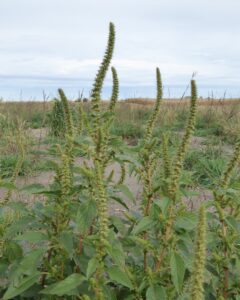 WeedOut is the technological cousin of SIT. Rather than insects, WeedOut harnesses pollen. Instead of releasing an army of sterile male insects to mate with females, WeedOut technology sends out irradiated pollen, in order for female Palmer plants to fertilize and then eventually abort seed, describes Efrat Lidor Nili, co-founder of WeedOut: “Every seed that is formed following fertilization with WeedOut pollen is 100% aborted.”
WeedOut is the technological cousin of SIT. Rather than insects, WeedOut harnesses pollen. Instead of releasing an army of sterile male insects to mate with females, WeedOut technology sends out irradiated pollen, in order for female Palmer plants to fertilize and then eventually abort seed, describes Efrat Lidor Nili, co-founder of WeedOut: “Every seed that is formed following fertilization with WeedOut pollen is 100% aborted.”
Each year, generally during the early stages of crop season, farmers spray chemical formulations, killing susceptible Palmer, yet leaving behind herbicide-resistant Palmer weeds. Every field plays the same spiraling tune, as remaining resistant Palmer proliferate in a population drift toward increased resistance. Tougher, stronger, and harder to kill. The never-ending resistance spiral is the precise point where WeedOut makes its entry, Nili explains. “Application of our product, when the escaper weeds are flowering,” she says, “will result in the formation of aborted seeds and will block the evolutionary shift towards more and more resistance.”
WeedOut is not a replacement for any particular weed control tool, including herbicides, but if used properly, could make a major impact on overall management, Nili contends: “WeedOut will be used as a part of an integrated weed management approach. In the beginning of the season, farmers will apply the standard chemical treatments, but once the weeds have passed a certain stage and chemicals are no longer effective, and they see flowering weeds in their fields, farmers will apply our pollen product to prevent a significant increase the following season in the number of resistant seeds in their ground that will germinate. Thus, from the second year onward, farmers will have fewer resistant seeds in their fields and therefore it will actually protect the entire set of products that are available today and are becoming less and less effective due to increased resistance. By blocking resistance we are protecting currently available products.”
Blow the Bank
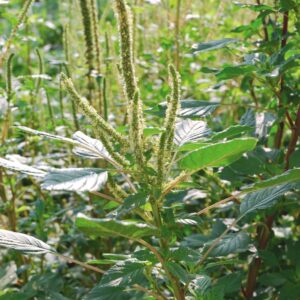 A little goes a long way, in regard to pollen. Nili estimates 120 grams (half a cup) per acre per season is effective against Palmer, spread across three applications. WeedOut researchers grow male Palmer plants in net houses in order to obtain pollen for radiation treatment. “We have developed a mechanized machine that harvests the pollen on a daily basis. (Palmer produces new pollen each day.) Following the collection step, the pollen undergoes an irradiation step. Our estimations are that one manufacturing acre of male Palmer will be enough to treat ~13,000 infested acres,” Nili says.
A little goes a long way, in regard to pollen. Nili estimates 120 grams (half a cup) per acre per season is effective against Palmer, spread across three applications. WeedOut researchers grow male Palmer plants in net houses in order to obtain pollen for radiation treatment. “We have developed a mechanized machine that harvests the pollen on a daily basis. (Palmer produces new pollen each day.) Following the collection step, the pollen undergoes an irradiation step. Our estimations are that one manufacturing acre of male Palmer will be enough to treat ~13,000 infested acres,” Nili says.
WeedOut is currently developing an adjustment tool for a boom sprayer, and intends to utilize drones for spot-spraying. In parallel, the company is developing liquid formulation delivery. The irradiated pollen is exclusive to Palmer and does not affect row crops or other plants, Nili emphasizes. WeedOut researchers intend to extend pollen treatment to other Amaranthus weeds, but currently, the first WeedOut product is specific to Palmer.
“The pollen itself is selective and is designed to target the weed only and not the crop. We do have plans for the future to reduce the amount of pollen needed by using a directed application using drones. Since we are currently using a dry application and pollen is extremely low weight it can fit very nicely,” says Orly Noivirt-Brik, co-founder of WeedOut.
Field trials conducted in the U.S. (cotton) and Israel (corn) have demonstrated ~50% efficacy of weed control, according to Nili. “This efficacy, that was obtained with our biological solution, is in the same range of weed control that is achieved today against Palmer amaranth with other commonly used chemical herbicides due to the high resistance problem. And their efficiency is only reducing from year-to-year.”
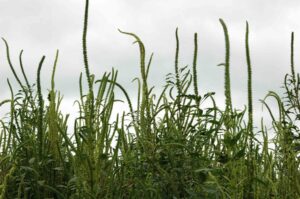 An attack on the seedbank—sans herbicide—is an absolute necessity for the future of row cropping, says Stanley Culpepper, University of Georgia Extension weed specialist. “When you think about this Palmer battle in agriculture, along with resistance, herbicides, and money spent, the way we ultimately win is at the seedbank, using every tool possible. If they can create a product (WeedOut) that reduces the viability of Palmer seed, and that can be implemented economically and successfully by growers, it’s something we need to really consider and study closely.”
An attack on the seedbank—sans herbicide—is an absolute necessity for the future of row cropping, says Stanley Culpepper, University of Georgia Extension weed specialist. “When you think about this Palmer battle in agriculture, along with resistance, herbicides, and money spent, the way we ultimately win is at the seedbank, using every tool possible. If they can create a product (WeedOut) that reduces the viability of Palmer seed, and that can be implemented economically and successfully by growers, it’s something we need to really consider and study closely.”
Yield reductions are a stark reminder of the risks associated with further advances of Palmer. Pulled directly from Culpepper’s work (bold type added): “Palmer amaranth reduced corn [Zea mays (L.)] yields 11 to 91% with 0.5 to 8 plants m-1 of row (Massinga and Currie 2002; Massinga et al. 2001) and reduced soybean yield 17 to 68% with 0.33 to 10 plants m-1 of row (Klingaman and Oliver 1994). Cotton lint yields in Texas decreased linearly from 13 to 54% as Palmer amaranth density increased from 1 to 10 plants in 9.1 m of row (Morgan et al. 2001).”
“Bottom line: We can’t survive relying exclusively on herbicides,” Culpepper adds. “In the future with the tools and technologies advancing as they are, if we can apply something that prevents the female Palmer amaranth plant from producing viable seed, that is a fantastic concept—because it requires no herbicide.”
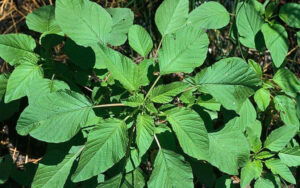 Designed to be delivered in successive years, WeedOut would optimally serve as seedbank control, consistently hacking at viable seed numbers. In a practical manner, each WeedOut application might be viewed as a pretreatment toward the following season. “The farmer will be able to see a reduced number of resistant seedlings the next year. It is intended for use year after year, similar to chemical products,” says Noivirt-Brik.
Designed to be delivered in successive years, WeedOut would optimally serve as seedbank control, consistently hacking at viable seed numbers. In a practical manner, each WeedOut application might be viewed as a pretreatment toward the following season. “The farmer will be able to see a reduced number of resistant seedlings the next year. It is intended for use year after year, similar to chemical products,” says Noivirt-Brik.
Farmers will inevitably ask: Could Palmer develop resistance to WeedOut? Nili doesn’t shy from the question. “Since we are attacking the natural reproduction of the weed, developing resistance is not going to be an easy task. It will require significantly more efforts compared to standard chemicals that attack a single biochemical pathway,” she says. “Yet, nature is always smarter than us, so we cannot exclude such a possibility.”
Need for Novel
Could WeedOut’s irradiated pollen approach be tailored for use against weeds in general? Weeds that proliferate by wind pollination or through cross pollination are ideal target candidates in the future, believes Nili. At present, WeedOut continues to hone treatment parameters for Palmer amaranth, in addition to upscaling pollen manufacturing, storage, and application. If testing is successful, the earliest availability of the first WeedOut product for Palmer control in the U.S. is targeted for 2023, projects Nili.
Biological control of weeds, she concludes, will become a standard part of agriculture. “There is an urgent need to develop novel solutions, since in the past 30 years no new mode of action has been developed. Since resistance is so widespread, with many cases of multiple resistance to various modes of action, there is a need to diversify the tactics to win the battle against resistant weeds. In addition, the population is becoming more and more aware to the needs of sustainable agriculture, to reducing the overall amount of chemicals that are used.”
Read the original article – CLICK HERE
